(单词翻译:单击)
中英文本
The river animals have it worst.
河流中生活的物种正经历最糟糕的困境。
Thanks to water extraction, dam building and other river-changing pursuits, more than three-quarters of river amphibians, fish and mammals have disappeared since 1970.
由于水源抽取、大坝建设及河道改迁等原因,自1970年以来超过四分之三的两栖动物、鱼类及哺乳动物已经从地球上消失。
That's not three quarters of species, mind you, it's three quarters of the individuals in a given population.
这里需要注意的是,不是四分之三的物种,而是一个族群的四分之三。
And it's not just the rivers.
不仅是河流里的动植物落得这样的下场,

Nearly 40 percent of both land and sea animals, from sardines to elephants, have disappeared over the same time span.
近40%的陆地及海洋生物,从沙丁鱼到大象无一幸免几乎都在同一时间从地球上消失。
The numbers are from a new report from the conservation group World Wildlife Fund.
这是来自野生动植物保护组织世界野生动植物基金会最新报告所公布的数据。
These lost animals have been replaced by either people or our domesticated animals—chickens, cows and pigs, among others.
这些消失的动物已经被人工养殖或者家养的鸡、奶牛、猪以及其它牲畜取代。
Farms to feed people displace forests that feed wildlife.
野生动植物提供给养的森林已经被为人们提供食物的农场所取代。
And people also eat wildlife directly, from fish to bushmeat.
此外,人们亦直接进食从鱼到兽肉的野生动植物。
As a result, the survey finds fewer and fewer individuals among more than 3,000 species and 10,000 populations surveyed.
结果这份调查报告在3000多物种及1万人口的调查中发现个体族群越来越少。
But there is hope.
但仍然存有希望。
The vast majority of these beleaguered species are not extinct.
大多数物种还没有灭绝。
And in rich regions like the U.S., Europe and Japan, wildlife numbers are actually increasing:
而比如美国、欧洲和日本等物种丰富的地方野生动植物的数量实际上呈现增长趋势:
coyote, deer, turkey and other forest animals, for example, as the forest regrows along the east coast of North America.
丛林狼、鹿、火鸡等其它一些森林中生活的动物,由于北美东海岸的森林再生,个体数量也在增加。
Exporting that trend could help stave off the gathering sixth mass extinction.
这一趋势有助于延缓第6次大规模物种灭绝。
词语解释
1.water extraction 水萃取;水抽提
It may be necessary to make special arrangements for water extraction, storage,and distribution.
有时,萃取、贮存和分发水源会需要特别安排。
METHOD The water extraction process and macroporous adsorption resin purifyprocess was study.
方法分别对水提取工艺和大孔吸附树脂纯化工艺进行了研究。
2.time span 时间跨度
Enable outgoing synchronization and set the time span.
激活外出性同步化并设置时间跨度。
“It’s a very clear-cut case of re-evolution because of the large time span,” saidJohn Wiens, the Stony Brook biologist who authored the paper in the journalEvolution.
约翰.威恩斯说“因长时间跨度而促使物种重新进化,这是一个非常明确的事例。” 他是斯托尼布鲁克分校生物学家,同时也签约日报进化栏作者。


